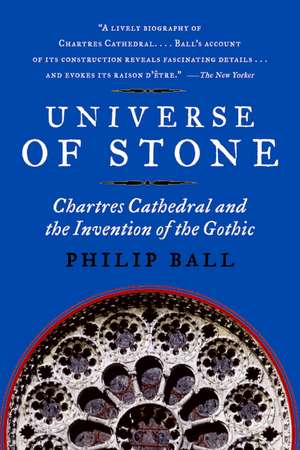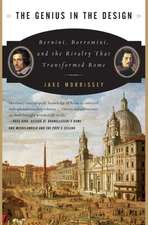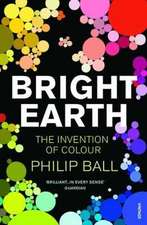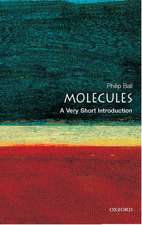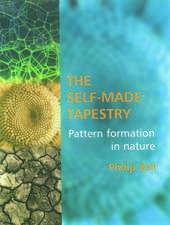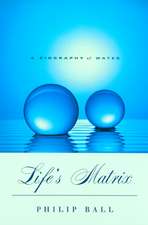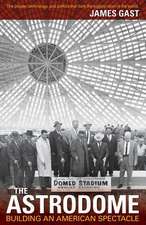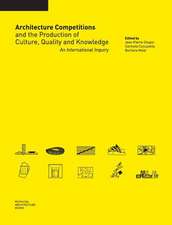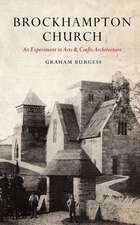Universe of Stone: Chartres Cathedral and the Invention of the Gothic
Autor Philip Ballen Limba Engleză Paperback – 27 iul 2009
Chartres Cathedral, south of Paris, is revered as one of the most beautiful and profound works of art in the Western canon. But what did it mean to those who constructed it in the twelfth and thirteenth centuries—and why was it built at such immense height and with such glorious play of light, in the soaring manner we now call Gothic?
In this eminently fascinating work, author Philip Ball makes sense of the visual and emotional power of Chartres and brilliantly explores how its construction—and the creation of other Gothic cathedrals—represented a profound and dramatic shift in the way medieval thinkers perceived their relationship with their world.
Beautifully illustrated and written, filled with astonishing insight, Universe of Stone embeds the magnificent cathedral in the culture of the twelfth century—its schools of philosophy and science, its trades and technologies, its politics and religious debates—enabling us to view this ancient architectural marvel with fresh eyes.
Preț: 113.63 lei
Nou
Puncte Express: 170
Preț estimativ în valută:
21.75€ • 22.62$ • 17.95£
21.75€ • 22.62$ • 17.95£
Carte disponibilă
Livrare economică 25 martie-08 aprilie
Preluare comenzi: 021 569.72.76
Specificații
ISBN-13: 9780061154300
ISBN-10: 006115430X
Pagini: 352
Dimensiuni: 152 x 229 x 21 mm
Greutate: 0.39 kg
Editura: HarperCollins Publishers
Colecția HarperPerennial
ISBN-10: 006115430X
Pagini: 352
Dimensiuni: 152 x 229 x 21 mm
Greutate: 0.39 kg
Editura: HarperCollins Publishers
Colecția HarperPerennial
Textul de pe ultima copertă
Chartres Cathedral, south of Paris, is revered as one of the most beautiful and profound works of art in the Western canon. But what did it mean to those who constructed it in the twelfth and thirteenth centuries—and why was it built at such immense height and with such glorious play of light, in the soaring manner we now call Gothic?
In this eminently fascinating work, author Philip Ball makes sense of the visual and emotional power of Chartres and brilliantly explores how its construction—and the creation of other Gothic cathedrals—represented a profound and dramatic shift in the way medieval thinkers perceived their relationship with their world. Beautifully illustrated and written, filled with astonishing insight, Universe of Stone embeds the magnificent cathedral in the culture of the twelfth century—its schools of philosophy and science, its trades and technologies, its politics and religious debates—enabling us to view this ancient architectural marvel with fresh eyes.
In this eminently fascinating work, author Philip Ball makes sense of the visual and emotional power of Chartres and brilliantly explores how its construction—and the creation of other Gothic cathedrals—represented a profound and dramatic shift in the way medieval thinkers perceived their relationship with their world. Beautifully illustrated and written, filled with astonishing insight, Universe of Stone embeds the magnificent cathedral in the culture of the twelfth century—its schools of philosophy and science, its trades and technologies, its politics and religious debates—enabling us to view this ancient architectural marvel with fresh eyes.
Recenzii
“A lively biography of Chartres Cathedral. . . . Ball’s account of its construction reveals fascinating details . . . and evokes its raison d’être.” — The New Yorker
“Ball brings to light a largely forgotten phase of human understanding. It is a considerable achievement.” — Peter Ackroyd, The Times (London)
“There is no better general introduction to the subject... [Ball’s] account is bold and plausible.” — Wall Street Journal
“Lively...Ball puts the fun back in medieval scholasticism...seems as much at ease on the medieval building site as in an abbey library.” — Los Angeles Times
“A terrific book…A lucid, thoughtful tour de force…A fascinating book with important insights and observations on every page.” — Christian Science Monitor
“Anyone who has been thrilled by the great Gothic cathedrals will revel in this study of both the spiritual and architectural qualities of those medieval wonders. Ball’s passion, sharp critical mind, and fluid prose open a window onto the remote, alien world we call the Middle Ages.” — Publishers Weekly (starred review)
“Ball leaves no stone unturned . . . A revelatory look at a seminal period in art history.” — Kirkus Reviews
“Ball brings to light a largely forgotten phase of human understanding. It is a considerable achievement.” — Peter Ackroyd, The Times (London)
“There is no better general introduction to the subject... [Ball’s] account is bold and plausible.” — Wall Street Journal
“Lively...Ball puts the fun back in medieval scholasticism...seems as much at ease on the medieval building site as in an abbey library.” — Los Angeles Times
“A terrific book…A lucid, thoughtful tour de force…A fascinating book with important insights and observations on every page.” — Christian Science Monitor
“Anyone who has been thrilled by the great Gothic cathedrals will revel in this study of both the spiritual and architectural qualities of those medieval wonders. Ball’s passion, sharp critical mind, and fluid prose open a window onto the remote, alien world we call the Middle Ages.” — Publishers Weekly (starred review)
“Ball leaves no stone unturned . . . A revelatory look at a seminal period in art history.” — Kirkus Reviews
Notă biografică
Philip Ball's book Bright Earth: Art and the Invention of Color was a finalist for the National Book Critics Circle Award; his Critical Mass: How One Thing Leads to Another won the UK's Aventis Prize. He is a consulting editor for Nature magazine, and he lives in London.
